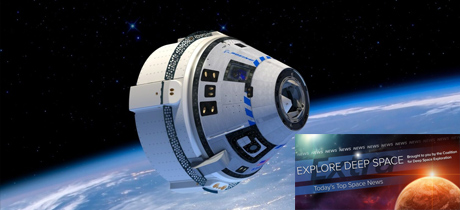In Today’s Deep Space Extra… Boeing announced plans Monday to re-fly an uncrewed test flight of its CST-100 Starliner to the International Space Station (ISS). NASA’s Marshall Space Flight Center anticipates a closure of many weeks. President Trump signs an executive order supporting the Outer Space Treaty and rejecting any treaty that constrains exploitation of space resources.
Human Space Exploration
Boeing says it’ll redo uncrewed flight test of Starliner space taxi to Space Station
Coalition Member in the News – Boeing
Geekwire.com (4/6): Boeing says it will redo the uncrewed test flight of its Starliner space taxi to the International Space Station (ISS), after months of reviewing what went wrong during a flight that fell short of the mark. NASA said it supported Boeing’s decision.
Marshall officials expect center closure to last for weeks
SpaceNews.com (4/6): Officials of NASA’s Marshall Space Flight Center anticipate it will be weeks yet before workers can return to on site operations due to the coronavirus pandemic. Much of the agency has been on telework status in response to the outbreak and a phased return to on site activity is anticipated in coordination with federal and state officials. While work to initiate a human lunar landing system has moved ahead at Marshall with telework, efforts to advance development of the Space Launch System (SLS) and Orion crew capsule at Marshall and the Michoud Assembly Facility in New Orleans have been impacted.
New executive order calls for international agreements for space resource rights, but no new treaty
Coalition Member in the News – United Launch Alliance
Spacepolicyonline.com (4/6): President Trump signed an executive order on Monday declaring it U.S. policy to seek out resources as it moves toward a 2024 return to the surface of the Moon to set the stage for the exploration of Mars. The president expressed compliance with the 1967 Outer Space Treaty in the intent. The U.S. was among other nations who declined to sign the 1979 Moon Treaty that stipulates the nonscientific use of space resources like those on the Moon or asteroids be regulated under an international framework.
Plans to seize territories of other planets harm international cooperation, says Roscosmos
TASS of Russia (4/7): Top Russian space agency officials reacted quickly to President Trump’s executive order with regard to making use of resources found on other planetary bodies. They warned that seizing assets could become an impediment to international cooperation in the exploration of space. (Editor’s note: TASS of Russia is a media outlet owned by the Russian Government)
Space Science
Need a distraction? The brightest supermoon of 2020 will rise on Wednesday
Science Alert (4/7): We could all use a distraction or two right now, and what better way to take your mind off what’s happening on this planet than by gazing at another celestial body? This Wednesday, April 8th, you’ll be able to see a ‘super pink Moon’ in the night sky.
Mars might be made of mashed up baby planets
Popular Science (4/2): Chemical analysis of two Martian meteorites of widely varying ages and recovered from Earth on the Antarctic and African continents suggest Mars has at least two sources of solid material and water. The study led by University of Arizona researcher Jessica Barnes was published in the journal Nature Geoscience.
Next stop, Enceladus? Scientists make their case for a mission to Saturn’s icy moon
Space.com (4/6): Like Saturn’s largest moon Titan, smaller Enceladus has shown past signs of geophysical activity, including geyser like eruptions of water below an icy crust. During a virtual meeting hosted by the National Academy of Sciences on March 31, planetary scientist Amanda Hendrix urged a mission to Saturn’s “ocean world” moon to investigate a potential habitable environment and presence of possible life forms.
Comet Atlas may be fragmenting
Spaceweather.com (4/6): Many were beginning to look forward to the possibility of a naked eye comet, Comet Atlas, possibly by late May and early June, as the comet reached its closed point to the sun in its elongated orbit. But new images from University of Maryland and Caltech astronomers suggest Atlas is fading and experiencing dynamic changes within its nucleus.
What smacked Uranus on its side? Something icy and as massive as Earth, scientists say.
Space.com (4/6): Giant Uranus’s tilt is unique among the planets in the solar system. Now, a Japanese led research effort may have modeled an explanation. Uranus was impacted by another object with perhaps three times the mass of Earth early after its birth. Findings were published in the journal Nature Astronomy.
Other News
What is the future for commercial suborbital spaceflight?
The Space Review (4/6): Just a few months ago, an optimism with ties to Virgin Galactic and Blue Origin was growing that commercial passenger suborbital spaceflight was near. That optimism has now faded due to the coronavirus pandemic and a volatile economy.
Apollo 13: A successful failure
The Planetary Society (4/6): The nation will mark the 50th anniversary of the Apollo 13 launch on Saturday. The Planetary Society takes a look back at what went wrong as Commander Jim Lovell, Fred Haise and Jack Swigert approached the Moon and experienced an explosion aboard their spacecraft, and what went right as the blast triggered a heroic effort within Mission Control as well as the spacecraft to save the three astronauts.

